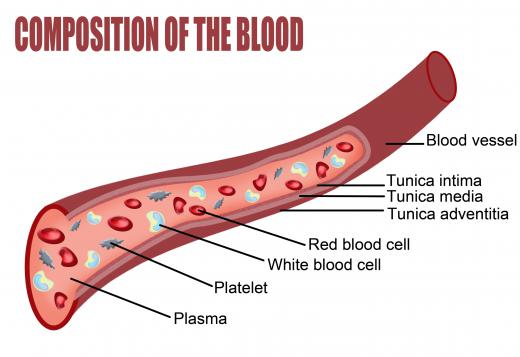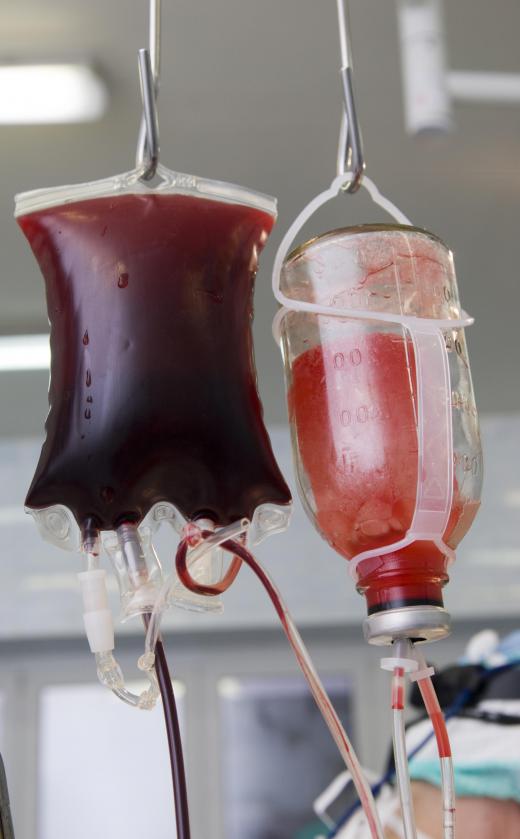What is the Primary Platelet Function?
Platelets are specialized cells that are important components of blood. The primary function of platelets is to prevent excessive internal or external bleeding after an injury. Platelets help to temporarily seal off the site of a wound by breaking away from other platelets and sticking to the exposed, damaged edges of blood vessels. The process by which platelets stop adhere to vessel walls to stop bleeding is known as hemostasis. When an individual experiences an abnormally high or low platelet count due to one of several blood disorders, emergency conditions such as hemorrhaging or excessive clotting can result.
Compared to red and white blood cells, platelets are very small and light. When blood flows through a vessel, the lightweight platelets are forced to the perimeter of the blood stream, where they surround the other blood cells and make contact with the vessel walls. Normally, platelets slide easily along these walls, which are known as the endothelium. When a cut, puncture, scrape, or internal injury causes the endothelium to tear apart, however, the platelets work to clot the blood and prevent it from continually exiting the wound.

The primary platelet function is to stick to exposed endothelial cells, providing a barrier against excessive blood loss. Platelets first break apart from one another and adhere to the exposed areas, where they bind with a chemical called fibrinogen. This synthesis creates the protein fibrin, which forms a tiny, almost threadlike boundary that keeps blood from flowing through the wound. The seal created by fibrin eventually dries and hardens, leaving a scab or bruise. Many different vitamins and minerals are important to ensure effective platelet function and fibrin synthesis, including calcium, vitamin A, and vitamin K.

Blood clotting is an absolutely essential process in preventing potentially serious or even life-threatening conditions. Abnormal platelet function can contribute to thrombosis, which is excessive clotting, or hemorrhaging, a drastic loss of blood through an exposed wound. Hemostasis can be disrupted when certain congenital or acquired conditions affect platelet function or production.

An individual with an unusually high platelet count, a condition known as thrombocytosis, is at risk of excessive blood clotting in the extremities or the brain. Clots obstruct blood flow and prevent oxygen from entering the brain, which can lead to strokes or permanent brain damage. A low platelet count, called thrombocytopenia, can cause hemorrhaging, and spontaneous bleeding from the skin or nose. When thrombocytosis or thrombocytopenia is detected in time, doctors can prescribe medications and treat underlying causes to restore normal platelet function.
AS FEATURED ON:
AS FEATURED ON:

















Discussion Comments
@StreamFinder -- I'm not a doctor, but from what I understand, there are a few different types of platelet function disorders.
They can fail to adhere to one another, for instance, in the case of Bernard-Soulier Syndrome, or they can fail to secrete properly.
This is called Gray Platelet Syndrome, and usually shows up as a long bleeding time, and a low platelet count.
Among other things, platelet disorders can be acquired as side effects of medication, or because of certain diseases.
In fact, some antibiotics can cause the platelets to malfunction, as can antidepressants and some blood thinners.
Finally, kidney disease and leukemia can be cause platelet disorders.
What are some of the more common types of platelet function disorders?
My sister is going in for a platelet function analysis test soon and I'm trying to get as much information as possible before that time.
Thank you!
In the case of a suspected compromise in platelet function, doctors often perform a platelet function assay.
Also known as a platelet function test, the doctors draw a small amount of blood, and then put it through a platelet function analyzer.
This analysis can help in diagnosing any number of conditions, including thrombocytosis, anemia, and in rare cases, certain cancers.
Post your comments